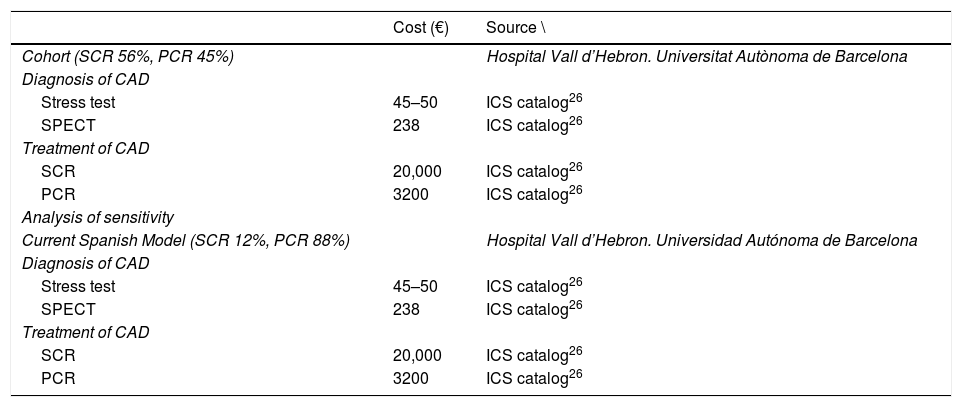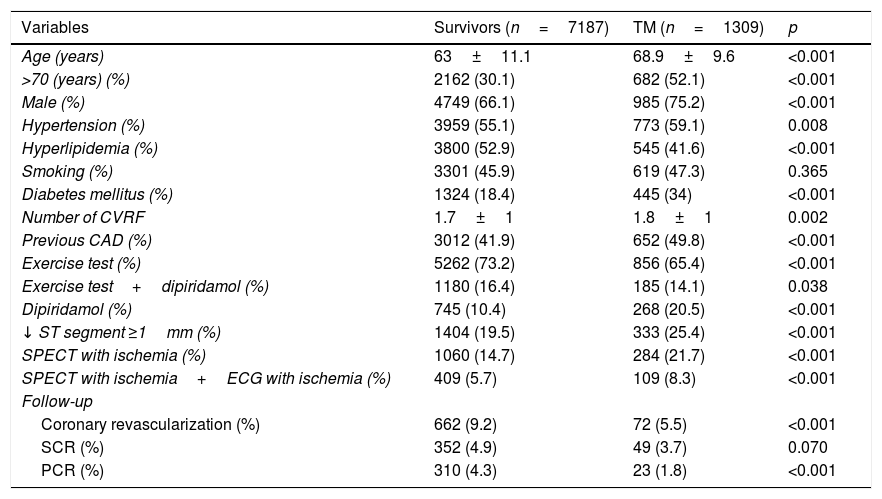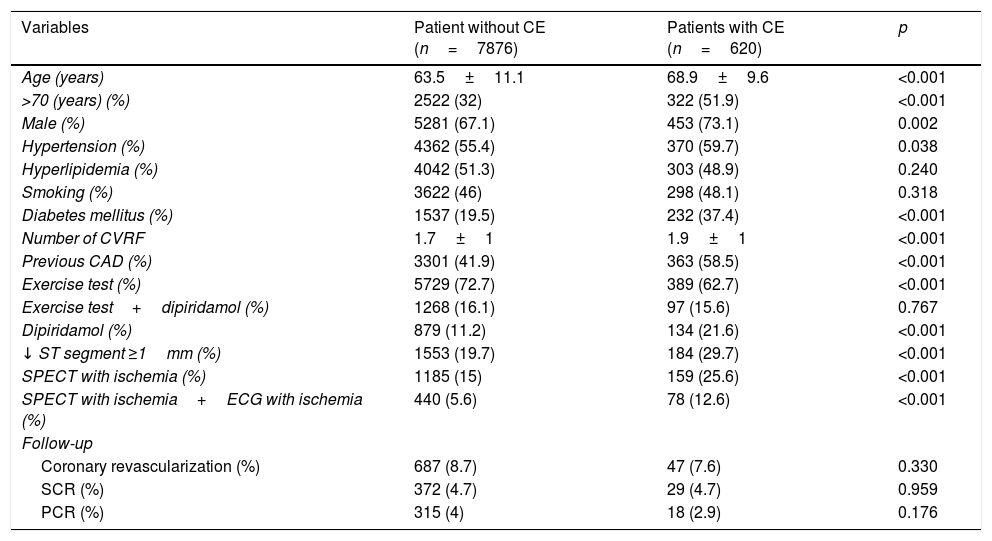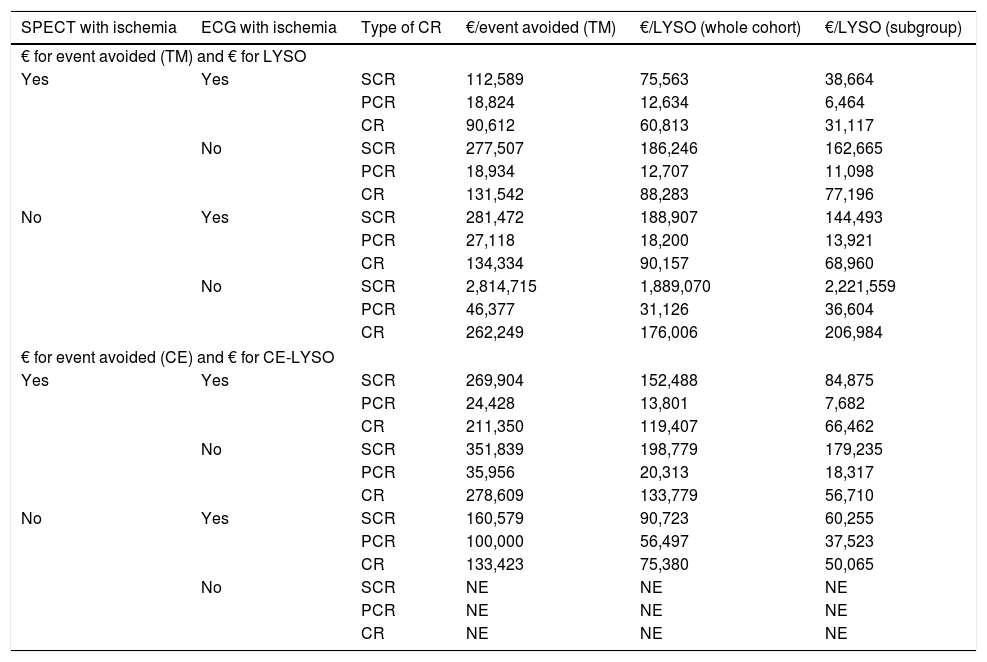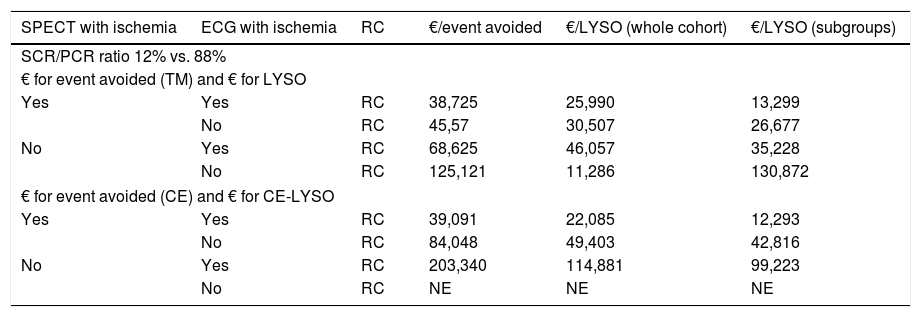The aim was to analyze the cost-effectiveness ratio (CER) of stress electrocardiogram (ES) and stress myocardial perfusion imaging (SPECT-MPI) according to coronary revascularization (CR) therapy, cardiac events (CE) and total mortality (TM).
Material and methodsA total of 8496 consecutive patients who underwent SPECT-MPI were followed-up (mean 5.3±3.5 years). Cost-effectiveness for coronary bypass (CABG) or percutaneous CR (PCR) (45.6%/54.4%) according to combined electrocardiographic ischemia and scintigraphic ischemia were evaluated. Effectiveness was evaluated as TM, CE, life-year saved observed (LYSO) and CE-LYSO; costs analyses were conducted from the perspective of the health care payer. A sensitivity analysis was performed considering current CABG/PCR ratios (12%/88%).
ResultsWhen electrocardiogram and SPECT approaches are combined, the cost-effectiveness values for CABG ranged between 112,589€ (electrocardiographic and scintigraphic ischemia) and 2,814,715€ (without ischemia)/event avoided, 38,664 and 2,221,559€/LYSO; for PCR ranged between 18,824€ (electrocardiographic and scintigraphic ischemia) and 46,377€ (without ischemia)/event avoided, 6464 and 36,604€/LYSO. To CE: the cost-effectiveness values of the CABG and CPR in presence of electrocardiographic and scintigraphic ischemia were 269,904€/CE-avoided and 24,428€/CE-avoided, respectively; and the €/LYSO of the CABG and PCR were 152,488 and 13,801, respectively. The RCE was maintained for the current proportion of revascularized patients (12%/88%).
ConclusionsCombined ES and SPECT-MPI results, allows differentiation between patient groups, where the PCR and CABG are more cost-effective in different economic frameworks. The major CER in relation to CR, CE and TM occurs in patients with electrocardiographic and scintigraphic ischemia. PCR is more cost-effective than CABG.
Análisis de la relación coste-efectividad (RCE) del electrocardiograma de esfuerzo y de la SPECT de perfusión miocárdica esfuerzo-reposo en relación con la revascularización coronaria (RC), eventos cardíacos (EC) y mortalidad total (MT).
Material y métodosSe estudiaron 8.496 pacientes con SPECT y seguimiento medio de 5,3±3,5años. Evaluamos la RCE para la RC quirúrgica (RCQ) y percutánea (RCP) (45,6%/54,4%) de acuerdo con los resultados de la isquemia electrocardiográfica y gammagráfica. La efectividad se evaluó como MT, EC, LYSO (life-year-saved-observed) y EC-LYSO. Los análisis de costes se realizaron desde la perspectiva del pagador de atención médica. El análisis de sensibilidad fue considerando las relaciones RCQ/RCP actuales (12%/88%).
ResultadosAl combinar los resultados del electrocardiograma de esfuerzo y de la gammagrafía, los valores de coste-efectividad para la RCQ variaron entre 112.589€ (isquemia electrocardiográfica y gammagráfica) y 2.814.715€ (sin isquemia)/evento evitado, y entre 38.664 y 2.221.559€/LYSO; y para la RCP entre 18.824€ (isquemia electrocardiográfica y gammagráfica) y 46.377€ (sin isquemia)/evento evitado, y entre 6.464 y 36.604€/LYSO. Para el EC: los valores de coste-efectividad de la RCQ y RCP en presencia de isquemia electrocardiográfica y gammagráfica fueron de 269.904€/EC evitado y de 24.428€/EC evitado, respectivamente; y los €/LYSO de la RCQ y RCP fueron de 152.488 y 13.801, respectivamente. Se mantuvo la misma RCE para la proporción actual de pacientes revascularizados (12%/88%).
ConclusionesEl análisis combinado de las imágenes de la SPECT y del electrocardiograma de esfuerzo permite la diferenciación entre grupos de pacientes en donde la RCP y la RCQ son más rentables. La mayor RCE en relación con la RC, EC y MT se da en los pacientes con isquemia electrocardiográfica y gammagráfica. La RCP es más coste-efectiva que la RCQ.
Article
If you experience access problems, you can contact the SEMNIM Technical Secretariat by email at secretaria.tecnica@semnim.es or by phone at +34 619 594 780.

Revista Española de Medicina Nuclear e Imagen Molecular (English Edition)





